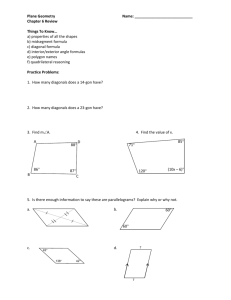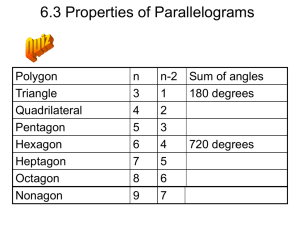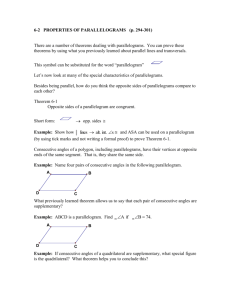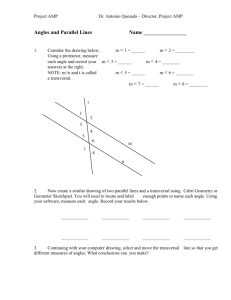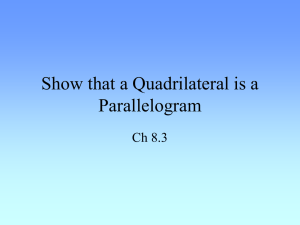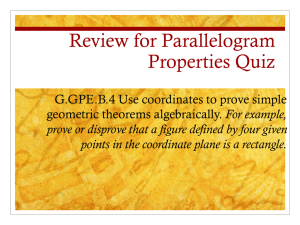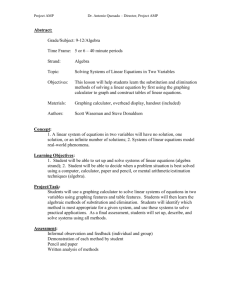Lesson Title: Properties of Parallelogram
advertisement
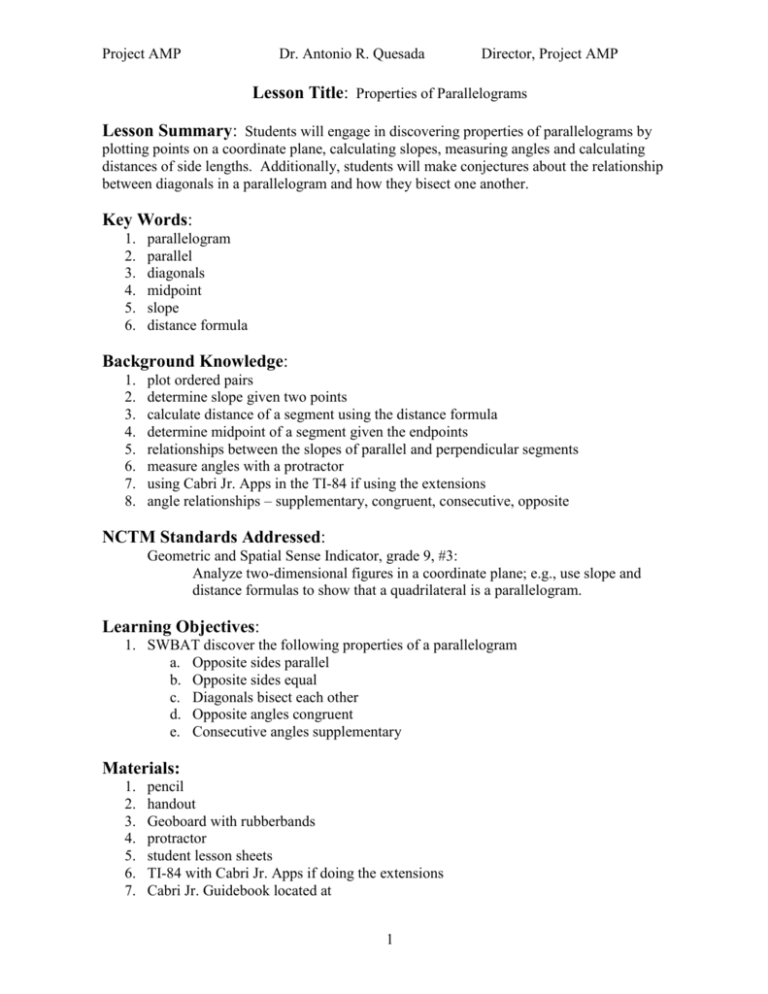
Project AMP Dr. Antonio R. Quesada Director, Project AMP Lesson Title: Properties of Parallelograms Lesson Summary: Students will engage in discovering properties of parallelograms by plotting points on a coordinate plane, calculating slopes, measuring angles and calculating distances of side lengths. Additionally, students will make conjectures about the relationship between diagonals in a parallelogram and how they bisect one another. Key Words: 1. 2. 3. 4. 5. 6. parallelogram parallel diagonals midpoint slope distance formula Background Knowledge: 1. 2. 3. 4. 5. 6. 7. 8. plot ordered pairs determine slope given two points calculate distance of a segment using the distance formula determine midpoint of a segment given the endpoints relationships between the slopes of parallel and perpendicular segments measure angles with a protractor using Cabri Jr. Apps in the TI-84 if using the extensions angle relationships – supplementary, congruent, consecutive, opposite NCTM Standards Addressed: Geometric and Spatial Sense Indicator, grade 9, #3: Analyze two-dimensional figures in a coordinate plane; e.g., use slope and distance formulas to show that a quadrilateral is a parallelogram. Learning Objectives: 1. SWBAT discover the following properties of a parallelogram a. Opposite sides parallel b. Opposite sides equal c. Diagonals bisect each other d. Opposite angles congruent e. Consecutive angles supplementary Materials: 1. 2. 3. 4. 5. 6. 7. pencil handout Geoboard with rubberbands protractor student lesson sheets TI-84 with Cabri Jr. Apps if doing the extensions Cabri Jr. Guidebook located at 1 Project AMP Dr. Antonio R. Quesada Director, Project AMP http://education.ti.com/guidebooks/apps/83cabri_jr/ti83pcabrijr_eng.pdf 2 Project AMP Dr. Antonio R. Quesada Director, Project AMP Suggested Procedures: The following activities may be modified to fit a jigsaw or activity stations format. 1. Introduction: Find Parallelograms in the Room Look around the room and try to find at least 5 examples of parallelograms. Write and draw these items in the table on your paper. 2. Activity 1: Lengths of Side Students will plot given points for a parallelogram on the coordinate plane, then calculate distance of the segments using the distance formula. They should then be able to determine that the opposite sides of a parallelogram are equal. 3. Activity 2: Slopes Students will plot given points for a parallelogram on a coordinate plane, then determine the slopes of opposite sides. They should then conclude that the opposite sides have the same slope. 4. Activity 3: Diagonal Relationship Students will plot given points for a parallelogram on a coordinate plane, then use the midpoint formula and the distance formula to determine the point of intersection. They should then conclude that the diagonals bisect each other. 5. Activity 4: Angle Relationship Students will build parallelograms given coordinates and a Geoboard. Students will measure the angles in the constructed parallelogram and discover similarities and differences. They should see that consecutive angles are supplementary and opposite angles are congruent. 6. Closure: Re-examine the Parallelograms around the Room Take out your list from the introduction of this lesson. Are there any objects you would change? How do you know that the objects on the list are parallelograms? Write a sentence next to each describing your thoughts. 7. Extension 1: Properties of Parallelograms 8. Extension 2: Parallelograms and TI Cabri Jr. Instructions Assessment: 1. Student lesson sheets 2. Questioning techniques during inquiry activity 3. The Closure Activity 4. Quiz 3 Project AMP Dr. Antonio R. Quesada Director, Project AMP Properties of Parallelograms Worksheet Lesson Goals: To engage in discovering properties of parallelograms by plotting points on a coordinate plane, calculating slopes, measuring angles and calculating distances of side lengths. To conjecture about the relationship between diagonals in a parallelogram and how they bisect one another. Directions: Look around the room and try to find at least 5 examples of parallelograms. Write and draw these items in the first and second columns of the table below, titled INTRODUCTION. Please do not write in the third and fourth columns, titled CLOSURE. INTRODUCTION Item Object name CLOSURE Is it a parallelogram? (yes / no) Picture 1 2 3 4 5 4 Why or why not? Project AMP Dr. Antonio R. Quesada 5 Director, Project AMP Project AMP Dr. Antonio R. Quesada Director, Project AMP Activity One 1. On a coordinate grid, plot and label the points A(6,2), B(17,5), C(13,12), and D(2,9). 2. What general shape will be formed if you connect A to B, B to C, C to D, and D to A? Connect each pair of points to verify your answer. 3. Use the distance formula, d ( x1 x2 )2 ( y1 y2 )2 , to determine the length of each of the segments. Length of AB = Length of BC = Length of CD = Length of DA = 4. What can you conclude about the lengths of the segments in this figure? 6 Project AMP Dr. Antonio R. Quesada Director, Project AMP Activity Two 1. On a coordinate grid, plot and label the points A(-7,5), B(-2,-4), C(8,-8), and D(3,1). 2. What general shape will be formed if you connect A to B, B to C, C to D, and D to A? Connect each pair of points to verify your answer. 3. Use the Slope formula, m ( y1 y2 ) , to determine the slopes of each of the segments. ( x1 x2 ) Slope of AB = Slope of BC = Slope of CD = Slope of DA = 4. What can you conclude about the slopes of the segments in this figure? 7 Project AMP Dr. Antonio R. Quesada Director, Project AMP Activity Three 1. On a coordinate grid, plot and label the points A(-3,0), B(-1,5), C(5,4), and D(3,-1). 2. What general shape will be formed if you connect A to B, B to C, C to D, and D to A? Connect each pair of points to verify your answer. 3. Remember that diagonals are segments that connect two non-adjacent vertices of a polygon. How many diagonals will the figure above have? Use a straightedge to draw the diagonals and verify your answer. 8 Project AMP Dr. Antonio R. Quesada Director, Project AMP x x y y 4. Using the Midpoint formula, midpoint 1 2 , 1 2 , find the midpoint of 2 2 diagonal AC . Plot and label this midpoint on the above coordinate plane as point F. 5. Use the distance formula, d ( x1 x2 )2 ( y1 y2 )2 , to determine the length of each of these segments. Length of AF = Length of CF = From these lengths, what can you verify? 6. Use the distance formula, d ( x1 x2 )2 ( y1 y2 )2 , to determine the length of each of these segments. Length of BF = Length of DF = From these lengths, what can you conclude? 7. What can you conclude about the diagonals in this figure? 9 Project AMP Dr. Antonio R. Quesada Director, Project AMP Activity Four Consecutive angles of a quadrilateral are two angles that share a common ray. Opposite angles of a quadrilateral are two angles that are located on either end of a diagonal, they are directly across from one another. Consider your Geoboard to be the first quadrant of the coordinate plane, as the picture illustrates below. y-axis x-axis Steps: 1. Assume that the bottom outside edge of the Geoboard is the x-axis and the left outside edge is the y-axis. Stretch the rubber band around these 4 coordinates to create a parallelogram. A(1,1) B(3,1) C(3,5) D(5,5) 2. Use a protractor to measure the angles at each of the vertices and record them below. m A = m B = m C = m D = 3. Do you notice any similarities or differences among the angle measurements? Explain. 10 Project AMP Dr. Antonio R. Quesada 11 Director, Project AMP Project AMP Dr. Antonio R. Quesada Director, Project AMP 4. Now stretch the rubber band around these 4 coordinates to create a different parallelogram. E(2,1) F(2,4) G(4,2) H(4,5) 5. Use a protractor to measure the angles at each of the vertices and record them below m E = m F = m G = m H = 6. Do you notice any similarities or differences among the angle measurements in the second parallelogram? Explain. 7. Based on your responses to the #1-6, what general statement(s) can you make about a property or properties found in all parallelograms regarding angle measurements? 8. Using your protractor draw a parallelogram below using only the angle measurements to guide you. Label the angle measurements in your parallelogram. 12 Project AMP Dr. Antonio R. Quesada Director, Project AMP QUIZ On a coordinate grid, plot and label the points A(-3,3), B(8,5), C(2,-1). Using the information that you discovered in the previous activities, where could you place point D in order to make a parallelogram? Please verify your solution by showing the slopes of the sides, the lengths of the sides, the midpoint of the diagonals as well as the angle measures. After you have found one point that makes a parallelogram, is it possible to find another point that will make a different parallelogram with the three given points? How many different points exist that will form a parallelogram with the three given points? List as many of these points as you can. 13 Project AMP Dr. Antonio R. Quesada Director, Project AMP Extension 1 I. Constructing a parallelogram A. What is the definition of a parallelogram? B. Open the Cabri Jr. APP on your calculator. Construct a parallelogram using the instructions that follow below or use the instructions for Method I or Method II that follow this extension. 1. In F1 open a New window. 2. Using the Segment tool under F2 draw a segment. 3. Label it AB with the Alp-Num tool in F5. 4. Draw AD using the Segment tool. 5. With the Parallel tool in F3, draw a line parallel to AB through pt. D. 6. Then draw a line parallel to AD through pt. B 7. Construct the point of intersection of the two lines and label it C using Intersection under Point in F2. 8. With the Quad tool in F2 draw quadrilateral ABCD. 9. Hide BC and DC using the Hide/Show tool in F5. 14 Project AMP Dr. Antonio R. Quesada 15 Director, Project AMP Project AMP Dr. Antonio R. Quesada Director, Project AMP C. Grab point A. To do this select point A, press clear (the cursor will switch to a hollow arrow), then press the Alpha key (the cursor will change to a hand), and then move point A around using the arrow keys. Does ABCD appear to stay a parallelogram? Try grabbing points B, C, and D. What happens? Which point can you not grab? Why do you think this is so? II. The Properties A. Sides Use D & Length under the Measure tool in F5 to measure the four sides. Then, grab pt. A and change the shape of ABCD. Record the new values. Length in 1st shape Side Length in 2nd shape AB BC DC AD Change the shape several more times. What do you notice is true about the lengths of the sides? B. Angles Using Angle in the Measure tool, find the number of degrees in each angle. Then, grab a point and change the shape of ABCD. Record the values. Angle A B C D 1st shape 2nd shape Find two relationships that appear to be true about the angles of a parallelogram. 1. 16 Project AMP 2. Dr. Antonio R. Quesada Director, Project AMP C. Diagonals Construct diagonals AC and BD . Construct their point of intersection and label it E. Measure the segments listed below. Then, change the shape and record the values. Length 1st shape 2nd shape AC BD AE BE CE DE What property about parallelograms can you state? What is not necessarily true about the diagonals? D. Angles formed by the diagonals 1. Measure the angles formed by the intersection of the diagonals. Change shapes. Can you make any conjecture about the angles? 2. Measure BAE and DAE. Change shapes. Is there any property that seems to be true? E. List the properties of parallelograms that you have found. 17 Project AMP Dr. Antonio R. Quesada Director, Project AMP F. Constructions using the properties. Each person in your group should construct a parallelogram using a different property. 18 Name: ______________________________________ Date: __________ Period:_____ Constructing a Parallelogram Using Cabri Jr. - Method I 1. In the F1 menu highlight New and press ENTER. 2. Open the F2 window, scroll to Segment, and press ENTER. 3. Draw a line segment. 4. Highlight Alp-Num in the F5 menu. 5. Label the segment AB . 6. Draw line segment AD . 7. In F3 select Parallel. 8. Highlight AB and press ENTER. 9. With the arrow keys move the parallel line up to pt. D so that D is blinking and press ENTER. 10. Construct a line parallel to AD . 19 Name: ______________________________________ Date: __________ Period:_____ 11. There are three choices under the Point tool. Select Intersection. 12. Move the cursor until both lines are blinking. Press ENTER. Label the point C. 13. Under F2 select the Quad tool. Select A, then B, C, and D. 14. Highlight the Hide/Show tool in F5 and press ENTER. 15. Select BC and press ENTER. 16. Hide DC . A figure will not disappear until the cursor is moved away from it. 20 Name: ______________________________________ Date: __________ Period:_____ Constructing a Parallelogram Using Cabri Jr. – Method II 1. In the F1 menu highlight New and press ENTER. 2. Open the F2 window, scroll to Segment, and press ENTER. 3. Draw a line segment. 4. Highlight Alp-Num in the F5 menu. 5. Label the segment AB . 6. Draw line segment AD . 7. In F3 select Parallel. 8. Highlight AB and press ENTER. 9. With the arrow keys move the parallel line up to pt. D so that D is blinking and press ENTER. 10. We need to copy the length of AB onto the line through D. For this use the Compass tool under F3. 21 Name: ______________________________________ Date: __________ Period:_____ 11. Highlight pt. B and press ENTER. Then highlight pt. A and press ENTER. 12. Using the arrow keys move the center of the circle from A to D. Be sure D is blinking. ENTER. Note: When you use the Compass tool, the first point that you highlight will be on the circle and the second point will be the center. It does not really matter which one you highlight first since you can move the circle. 13. There are three choices under the Point tool. Select Intersection. 14. Move the cursor until both the line and the circle are blinking. Press ENTER. Label pt. as C. 15. Under F2 select the Quad tool. Select A, then B, C, and D. 16. Highlight Hide/Show in F5 and press ENTER. Note: The order in which you select the points does not matter. 17. Move the cursor until the circle is blinking. Press ENTER. 18. Hide line DC . A figure will not disappear until the cursor is moved away from it 22

